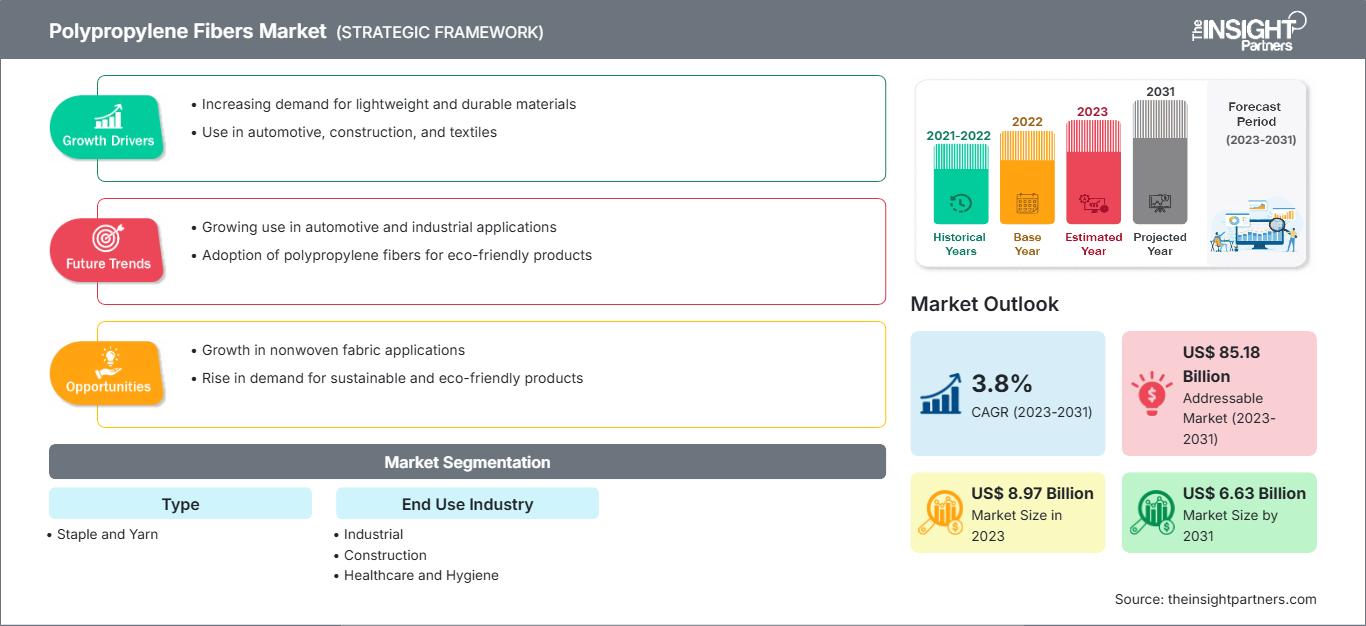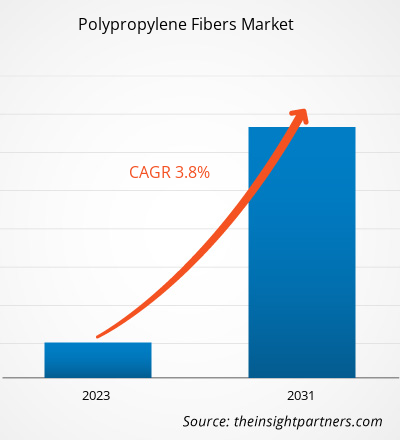聚丙烯纤维市场规模预计将从 2023 年的 89.7 亿美元增至 2031 年的 66.3 亿美元。预计该市场在 2023 年至 2031 年的复合年增长率为 3.8%。对医疗保健和卫生产品的需求可能仍是聚丙烯纤维市场的主要趋势。
聚丙烯纤维市场分析
建筑行业对聚丙烯纤维的需求不断增长,促进了聚丙烯纤维市场的增长。混凝土是一种广泛使用的建筑材料,因为它可用于可持续建筑。通常将聚丙烯添加到水泥基质中以提高混凝土的抗拉强度。纤维增强混凝土由于抗拉强度更高,与普通混凝土相比更不易开裂,因此更加耐用。全球建筑业正在快速增长。此外,欧洲国家正在通过改革和立法来创建和加强其基础设施,从而推动房地产和基础设施行业的发展。根据欧洲建筑业联合会的数据,2021 年德国新建筑(不包括土木工程)的许可额为 1,300 亿美元,比 2020 年增长 8%。在北美,建筑业是该地区经济的重要贡献者之一。根据美国建筑总承包商协会 (AGC) 的数据,美国建筑业每年建造的建筑物价值 1.8 万亿美元。由于人口增加和该地区商业部门的快速增长,建筑活动增加,推动了北美建筑业的发展。这些举措产生了对建筑服务、设备和材料的需求。亚太地区的政府和监管机构正专注于基础设施投资。在印度,工业化程度不断提高、人口不断增加、中产阶级收入不断增长以及基础设施建设不断加强是建筑活动增长的原因。根据国家投资促进与投资部的数据,据印度建筑促进局称,预计到 2025 年,印度建筑业的规模将达到 1.4 万亿美元。此外,印度政府的“全民住房”、“智慧城市计划”和“清洁印度运动”等举措预计将刺激印度对建筑材料的需求。因此,尤其是在发展中经济体,不断增长的建筑活动对聚丙烯纤维产生了巨大的需求。此外,聚丙烯纤维是无纺布加工中必不可少的纤维,在许多无纺布市场占据主导地位。
聚丙烯纤维市场概况
聚丙烯纤维是一种由丙烯聚合获得的线性聚合物合成纤维。它具有重量轻、强度高、韧性高和耐腐蚀等优点。聚丙烯纤维广泛应用于化工、能源、服装、环保和建筑领域。聚丙烯纤维是一组合成纤维,它具有某些特性,使其成为建筑材料的理想选择,尤其是在需要混凝土时。聚丙烯纤维通常由连续或不连续的纤维排列在塑料基质上,用作增强材料。
自定义此报告以满足您的要求
您将免费获得任何报告的定制,包括本报告的部分内容,或国家级分析、Excel 数据包,以及为初创企业和大学提供超值优惠和折扣
聚丙烯纤维市场: 战略洞察

- 获取本报告的主要市场趋势。这个免费样本将包括数据分析,从市场趋势到估计和预测。
您将免费获得任何报告的定制,包括本报告的部分内容,或国家级分析、Excel 数据包,以及为初创企业和大学提供超值优惠和折扣
聚丙烯纤维市场: 战略洞察

- 获取本报告的主要市场趋势。这个免费样本将包括数据分析,从市场趋势到估计和预测。
聚丙烯纤维市场驱动力与机遇
纺织行业需求不断增长
聚丙烯纤维在纺织品中的主要应用领域包括无纺布。根据印度国家投资促进与便利化局2020年发布的报告,印度纺织品市场总量的13%由技术纺织品构成。报告显示,由于国防、体育、医疗保健、建筑和汽车应用领域的应用不断增加,技术纺织品已成为印度快速增长的细分市场。此外,名为“国家技术纺织品使命”的倡议由内阁经济事务委员会 (CCEA) 设立的该委员会的目标是到 2024 年将技术纺织品的市场规模扩大到平均 15% 至 20%。根据美国商务部 2020 年发布的报告,欧洲各国政府对个人安全和防护服实施的严格规定推动了欧洲技术纺织品和智能面料市场的发展。中国工业和信息化部估计 2019 年中国对多轴织物的需求量为每年 40 万吨。因此,纺织行业的发展正在推动聚丙烯纤维市场的发展。
卫生用品使用量的增加
聚丙烯纤维因其强度高、重量轻、柔软、回水率低等特点,用于生产纸尿裤和卫生巾等一次性卫生用品。柔软性和疏水性使聚丙烯纤维适用于卫生用品和成人失禁产品。由于人们健康意识的增强,卫生用品的使用量不断增加,预计在预测期内将为聚丙烯纤维带来潜在机会。
聚丙烯纤维市场报告细分分析
促成聚丙烯纤维市场分析的关键细分市场是基础油、产品类型和最终用途行业。
- 根据材料,聚丙烯纤维市场分为短纤和纱线。短纤部分在 2023 年占据了更大的市场份额。
- 就最终用途行业而言,市场分为工业、建筑、医疗保健和卫生、农业、家具等。纺织部门在 2023 年引领市场。
按地区划分的聚丙烯纤维市场份额分析
聚丙烯纤维市场报告的地理范围主要分为五个区域:北美、亚太地区、欧洲、中东和非洲以及南美/南美和非洲。中美洲。
亚太地区在聚丙烯纤维市场占据主导地位。该地区的强劲增长得益于建筑业的发展以及对可持续实践的日益重视。中国和印度正在经历城镇化进程和住宅市场的扩张,这为聚丙烯纤维市场的主要参与者提供了充足的机会。中国是聚丙烯纤维最大的市场之一,这得益于该国庞大的建筑设施。中国是全球增长最快的经济体之一。预计未来几年亚太地区也将以最高的复合年增长率增长。
聚丙烯纤维聚丙烯纤维市场区域洞察
The Insight Partners 的分析师已详尽阐述了预测期内影响聚丙烯纤维市场的区域趋势和因素。本节还讨论了北美、欧洲、亚太地区、中东和非洲以及南美和中美洲的聚丙烯纤维市场细分和地域分布。
聚丙烯纤维市场报告范围
| 报告属性 | 细节 |
|---|---|
| 市场规模 2023 | US$ 8.97 Billion |
| 市场规模 2031 | US$ 6.63 Billion |
| 全球复合年增长率 (2023 - 2031) | 3.8% |
| 历史数据 | 2021-2022 |
| 预测期 | 2023-2031 |
| 涵盖的领域 |
By 类型
|
| 覆盖地区和国家 | 北美
|
| 市场领导者和主要公司简介 |
|
聚丙烯纤维市场参与者密度:了解其对业务动态的影响
聚丙烯纤维市场正在快速增长,这得益于终端用户需求的不断增长,而这些需求的驱动因素包括消费者偏好的不断变化、技术进步以及对产品优势的认知度不断提高。随着需求的增长,企业正在扩展产品线,不断创新以满足消费者需求,并抓住新兴趋势,从而进一步推动市场增长。

- 获取 聚丙烯纤维市场 主要参与者概述
聚丙烯纤维市场新闻及最新动态
聚丙烯纤维市场评估通过收集一手和二手资料后的定性和定量数据进行,这些资料包括重要的企业出版物、协会数据和数据库。以下是市场发展情况:
- 博略纤维国际公司 (Beaulieu Fibres International) 是欧洲规模最大、差异化程度最高的短纤维生产商,将于 3 月 28 日至 31 日在 IDEA®22 展会上(展位号 4314)重点展示面向未来的非织造布和工程织物解决方案。(来源:博略纤维国际公司,新闻稿,2022 年)
聚丙烯纤维市场报告内容及交付成果
《聚丙烯纤维市场规模及预测(2021-2031)》报告提供了涵盖以下领域的市场详细分析:
- 范围内涵盖的所有关键细分市场的全球、区域和国家/地区规模和预测
- 市场动态,例如驱动因素、限制因素和关键机遇
- 主要的未来趋势
- 详细的波特五力模型和 SWOT 分析
- 全球和区域市场分析,涵盖关键市场趋势、主要参与者、法规和最新市场发展
- 行业格局和竞争分析,涵盖市场集中度、热图分析、知名参与者和最新发展
- 详细的公司简介
- 历史分析(2 年)、基准年、预测(7 年)及复合年增长率
- PEST和SWOT分析
- 市场规模、价值/数量 - 全球、区域、国家
- 行业和竞争格局
- Excel 数据集
近期报告
客户评价
购买理由
- 明智的决策
- 了解市场动态
- 竞争分析
- 客户洞察
- 市场预测
- 风险规避
- 战略规划
- 投资论证
- 识别新兴市场
- 优化营销策略
- 提升运营效率
- 顺应监管趋势




















 获取免费样品 - 聚丙烯纤维市场
获取免费样品 - 聚丙烯纤维市场